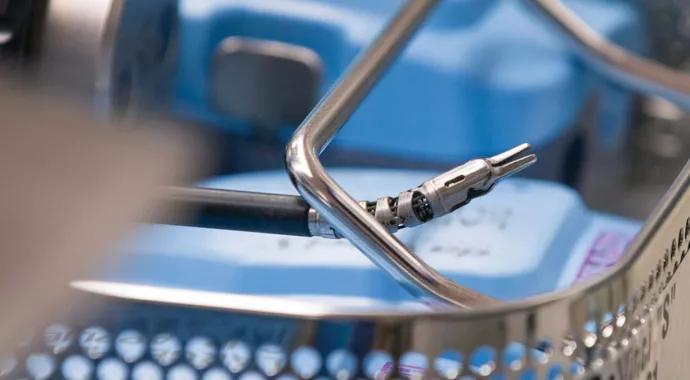Advertisement
Evolving surgical techniques yield promising results

Advertisement
Cleveland Clinic is a non-profit academic medical center. Advertising on our site helps support our mission. We do not endorse non-Cleveland Clinic products or services. Policy
A 59-year-old woman presented to Dr. Rodriguez’s office for evaluation of abdominal pain that was significantly altering her quality of life. During her examination, he found what appeared to be an abdominal hernia. A CT scan of the abdomen later confirmed this diagnosis.
She developed the hernia after an operation done to remove a cancer in the endometrium. The hernia had enlarged over time and required a more complex operation for repair. Dr. Rodriguez recommended an abdominal wall reconstruction to give this patient the best chance of a long-lasting repair. Incisional hernias can develop after abdominal operations when fascial tissues fail to properly heal. This can happen for many reasons including technical failure, wound infections or patient-related factors that affect proper wound healing.
There are many considerations that come into play when selecting the proper technique for hernia repair. The main goal is to provide patients with the best possible operation to minimize the risk of recurrence, which can be as high as 30 percent. A posterior component separation best known as a transverse abdominis release was needed to reconstruct this patient’s abdominal wall. This operation is typically performed through a large open incision and is followed by a prolonged recovery phase. The team from the Digestive Disease Institute at Cleveland Clinic has been using minimally invasive techniques to perform complex abdominal operations through small incisions. Dr. Rodriguez felt that this was a great opportunity to apply robotic technology to perform the same open operation through a laparoscopic approach.
Advertisement
Dr. Rodriguez teamed up with Michael Rosen, MD, a world renowned hernia expert who serves as Director of Cleveland Clinic’s Hernia Center to perform the first robotic assisted abdominal wall reconstruction in Ohio.
The patient was taken to the operating room and had a successful abdominal wall reconstruction. The use of advanced minimally invasive techniques and robotic technology, allowed the surgical team to replicate the standard open technique using only a few small incisions. The operation was uneventful. She made an unremarkable recovery and was able to leave the hospital on postoperative day 1. The benefits of this approach were seen very quickly by the patient and her medical team. Patients undergoing this kind of surgery typically stay in the hospital an average of five days and require major efforts to help control pain.
Hernias of the abdominal wall are one of the most common problems seen by general surgeons. The evolution of surgical techniques has focused on decreasing complications and recurrence rates. Component separation techniques have proven to be the best option for patients with large or complex abdominal hernias. The use of synthetic mesh has helped decrease recurrence rates. The use of minimally invasive techniques has the potential to decrease length of stay, wound complications and improve postoperative pain.
Dr. Rodriguez is a general surgeon in Cleveland Clinic’s Digestive Disease Institute. He specializes in foregut surgery, bariatric surgery, gastroparesis, hernia surgery, advanced laparoscopy and endoscopy. He can be contacted at rodrigj3@ccf.org.
Advertisement
Advertisement

Insights from Cleveland Clinic’s Vice Chair of Innovation and Technology

Cleveland Clinic study finds that durable weight loss is key to health benefits

Findings could help promote organ preservation

A proof-of-concept study shows how 3D pouchography can be a useful adjunct for surgeons

The new appointee brings special expertise in hereditary and young-onset colorectal cancer

New research shows dramatic reduction in waitlist times with new technology

Potential for new, non-invasive screening option

Provider vigilance and patient education are key for management